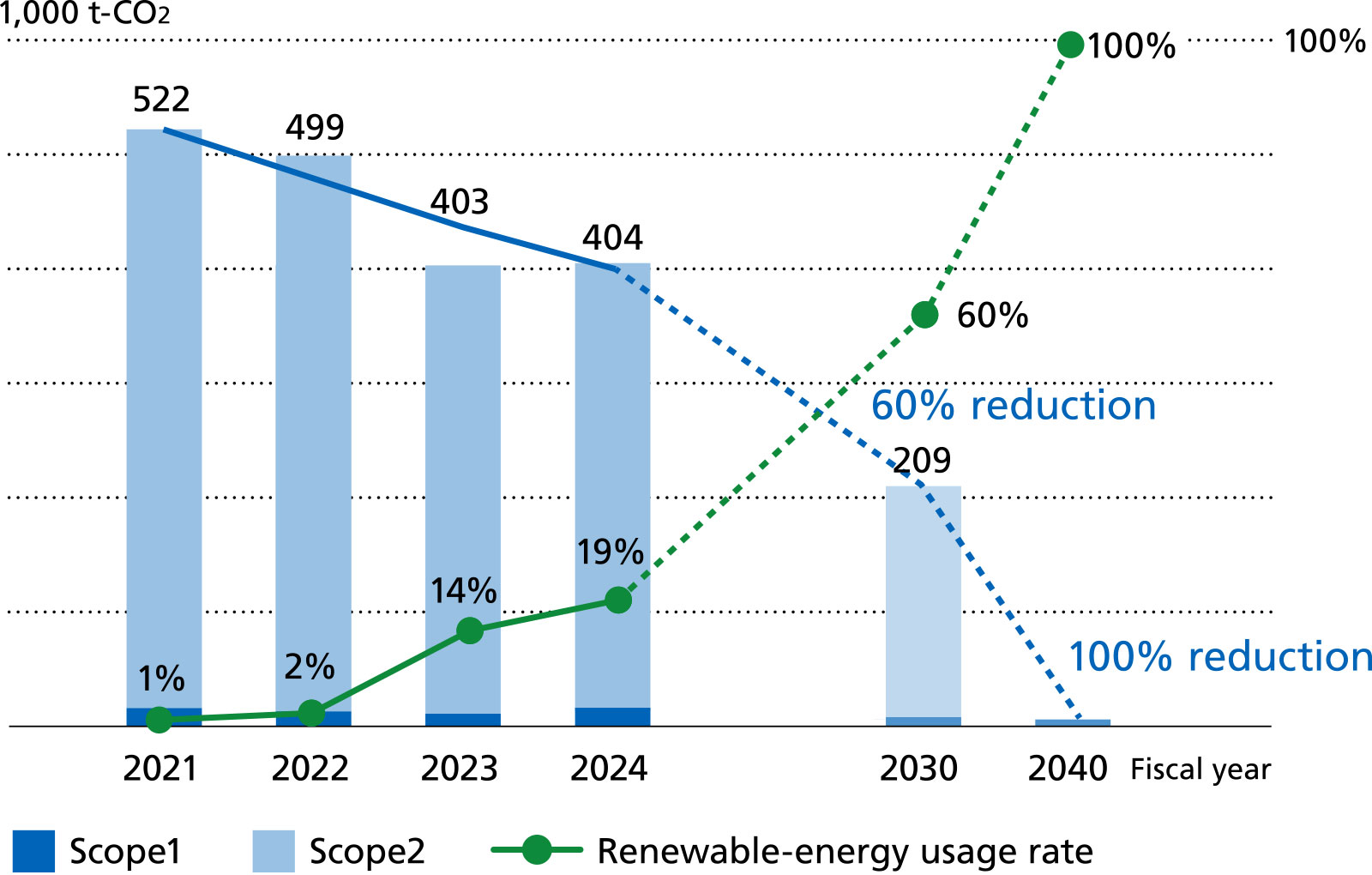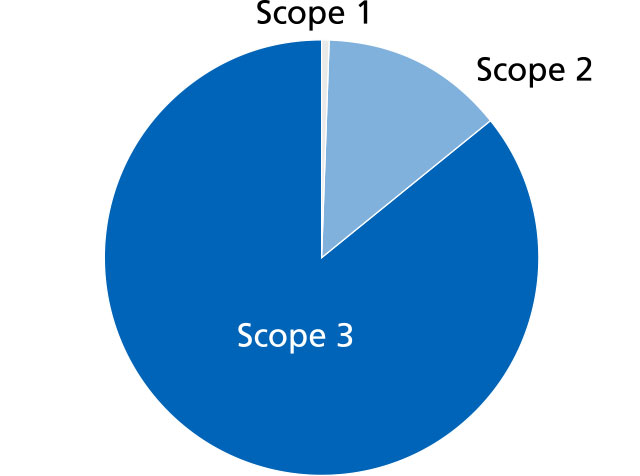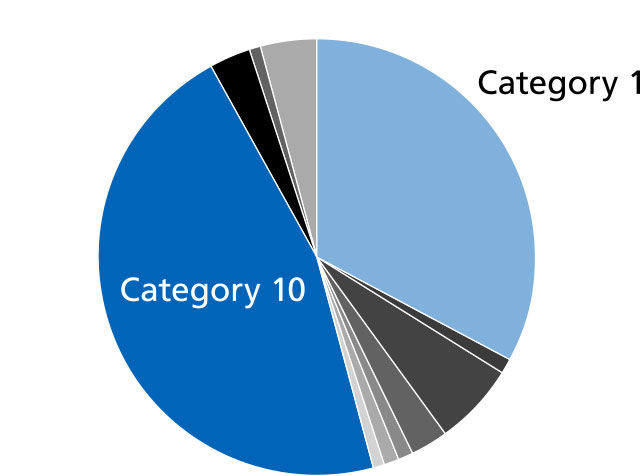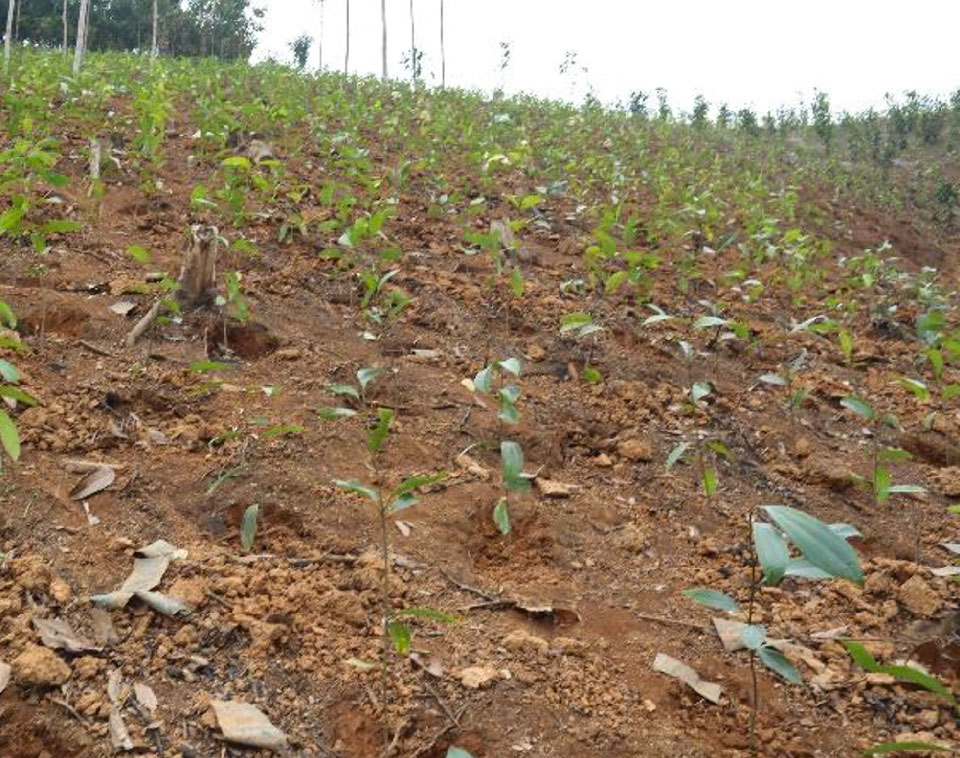Environmental
Climate Change
Response to climate change
In 2021, the HOYA Group identified four material issues, with the reduction of greenhouse gas (GHG) emissions designated as the highest priority across the Group. In April 2023, we began disclosing climate-related information for the first time in line with the recommendations of the Task Force on Climate-related Financial Disclosures (TCFD), thereby strengthening our response to climate-related risks.
Furthermore, in February 2023, we joined RE100, a global initiative that aims to accelerate the transition to 100% renewable electricity in corporate operations worldwide. The HOYA Group is committed to sourcing 100% of its electricity from renewable energy by fiscal 2040 and is actively accelerating efforts to achieve this goal.

Medium- to long-term targets and results for greenhouse-gas emissions reduction
Over 90% of the HOYA Group’s greenhouse-gas (GHG) emissions (total of Scope 1 and Scope 2) are in Scope 2; the majority of these are indirect emissions arising from purchased electrical power. As such, by aggressively advancing the transition to electricity from renewable sources that do not emit GHGs, the Group is effectively slashing CO₂ emissions.
The goal of this initiative is to achieve a renewable-energy usage rate of 100% by fiscal 2040, and we are aiming for an interim target of 60% by fiscal 2030.
To achieve these targets, each business division is developing and implementing medium- to long-term roadmaps for the introduction of renewable energy and CO₂ reduction measures is working together as one to formulate and implement measures throughout the HOYA Group.
CO₂ Emissions and Renewable-Energy Usage Rate

GHG emissions for fiscal 2024 were 17 kt-CO₂ for Scope 1 emissions and 387 kt-CO₂ for Scope 2 (market-basis) emissions, for a total of 404 kt-CO₂*, representing a reduction of approximately 23% compared to the base year (fiscal 2021). Furthermore, despite increased production volumes across all businesses, we reduced emissions per consolidated net sales by 12% year on year as a result of expanding the introduction of renewable energy and actively promoting energy conservation. In addition, electricity consumption per product, which is a key performance indicator (KPI) for major business segments, also decreased. In addition, the renewable-energy usage rate increased by 5 percentage points year-on-year to 19%.
Through these initiatives, we will aim to achieve both sustainable growth and reduced environmental impact.
* From fiscal 2024, GHG emissions associated with leased vehicles and leased warehouses, which are booked as right-of-use assets for accounting purposes, are included in Scope 1 and Scope 2, respectively (approximately 2% of total emissions).
Since fiscal 2021, greenhouse gas emissions (Scope 1 and Scope 2, energy consumption) have been verified by a third party through limited-assurance operations. In the course of the verification process, the method of calculation and coefficient used to calculate CO₂ were revised, resulting in correction of the figures disclosed in February 2023.
The Group is considering offsets using carbon credits for the residual emissions after maximum reduction efforts are made for Scope 1.
For data on Scope 1 and Scope 2 results, please refer to the Environment page of the ESG Databook.
Introduction of renewable energy
We are moving forward with switching to renewable energy at each production and sales site. In fiscal 2024, the number of production sites with solar panels increased to nine from four, and the Group is also accelerating conversion to purchase of renewable energy by reviewing electrical-power agreements and using energy attribute certificates, focusing on countries in which renewables are readily available. The Vision Care Division has achieved virtually 100% renewable energy use at the Matsushima Plant and all other domestic sites in Japan as well as multiple production sites overseas (Hungary, Germany, Italy, Spain, Indonesia, and certain sites in the United States). In addition, all Eye City contact lens stores (including offices) and HOYA Global head office (Japan) have already achieved virtually 100% renewable-energy usage, by means of FIT non-fossil-fuel certificates. We will place more importance on the perspective of introducing renewable energy power with additionality and will actively promote initiatives to achieve the goal.

Solar panels installed at HOYA LAMPUN LTD. (Annual generating capacity: about 2,200 MWh; Annual CO₂ reduction volume: about 1,000 t-CO₂)
Initiatives to raise energy efficiency
As energy conservation activities at production sites, we are replacing facilities with energy-saving types (such as adopting ice thermal storage systems and high-efficiency transformers). We are also optimizing the operating hours of boilers and air-conditioning equipment and promoting roof-greening, etc.
Since electricity is the main source of energy consumption, we are analyzing the breakdown of power use by equipment in our factories and developing plans for equipment upgrades and transitions.
We are also endeavoring to suppress CO₂ emissions from non-production sites by such means as introducing casual dress codes, optimizing the indoor temperature and implementing efficient lighting.
Specific Initiatives
Implementation of capital investment plans based on visualization of equipment energy efficiency
We surveyed the power consumption of all electrical equipment at HOYA’s contact lens and intraocular lens production site in Thailand over a one-month period. This enabled us to visualize the energy efficiency of each piece of equipment and formulate investment plans based on comparisons with the performance of the latest equipment.Reduction of CO₂ emissions through switching to high-efficiency equipment
Injection-molding machines were replaced from hydraulic to electric at some eyeglass lens production sites, significantly reducing CO₂ emissions at those sites. In addition, at another site, we have replaced air-cooled chillers, which accounted for a large portion of the factory's total power consumption, with high-efficiency, magnetically driven water-cooled chillers, resulting in an approximately 40% reduction in CO₂ emissions. We are continuing to introduce optimal equipment tailored to the energy usage conditions of each site.
Initiatives to measure and reduce CO₂ emissions across the entire supply chain
In fiscal 2024, the HOYA Group made significant progress in its efforts to calculate CO₂ emissions in the entire supply chain.
Whereas Scope 3 calculations previously focused only on major categories of emissions, we have expanded the scope of measurement to include all categories across all business divisions. When looking at emissions by scope, Scope 3 accounts for a large proportion, with Category 1 (Purchased Goods and Services) and Category 10 (Processing of Sold Products) accounting for the largest shares.
As our business is mainly engaged in manufacturing, we procure a large volume of raw materials and parts, so Scope 3 Category 1 emissions, which are emissions from the manufacturing processes of our suppliers, are our main source of emissions. In addition, because many of our products are intermediate materials that are further processed by our customers, the emissions associated with such post-sale processing are classified as Scope 3 Category 10 and account for a significant proportion of our overall emissions.
In the future, we will work to improve the efficiency and accuracy of data collection for Scope 3 emissions calculations, strengthen engagement with related companies in the supply chain to realize a sustainable society and take steps to reduce emissions. To ensure alignment with international climate goals, we also aim to obtain Science Based Target (SBT) certification as we move forward with Scope 3 reduction initiatives.
Emissions by Scope

Emissions by Scope 3 Category

For data on Scope 3 results, please refer to the Environment page of the ESG Databook.
Scenario analysis based on the TCFD recommendations
From fiscal 2022, the HOYA Group began scenario analysis based on the TCFD recommendations. In the first year, the Group focused on two business divisions, eyeglass lenses and glass substrates for HDDs, with high CO₂ emissions (high power consumption). We conducted analysis using 4°C and 1.5°C scenarios with a time horizon of fiscal 2030, targeting factories in Thailand and Vietnam, which are the main production sites for these divisions. In fiscal 2023, the scope of scenario analysis was widened to include the Optics Division (optical lenses). The combined CO₂ emissions of these three business divisions account for approximately 88% of the HOYA Group's total CO₂ emissions. We also conducted a risk assessment of all our production sites with respect to physical risk (flooding), which we have positioned as a key climate change risk.
The HOYA Group will continue to conduct regular reviews in response to changes in the external environment, reflecting the results of scenario analysis in its business activities and strengthen responses to risks and opportunities and thus build resilience to climate change.
Examples of risks and opportunities in the eyeglass lenses business division (excerpt from moderate or higher risks)
Description |
Response |
|
|---|---|---|
Transition risks |
・Delays in responding to consumers’ heightened awareness of climate change results in lost market share and/or declining sales. ・Action on climate change and climate-related disclosure have been added to factors customers use to select suppliers. Delay in responding results in lost customers and/or declining sales. ・Inadequate response to environmental issues such as reduction of CO₂ emissions and water recycling causes loss of reputation and/or declining sales. |
・Consideration of listing CO₂ emissions on product packaging ・Revision of marketing strategy: Reduction of impact from climate change through product innovation; enhanced dissemination of information ・Regular reporting to customers and other external stakeholders regarding progress on ESG ・Expansion of disclosure related to climate change, such as TCFD or the Carbon Disclosure Project (CDP) |
Physical risks |
Infectious-disease outbreaks made possible by unusual weather disrupt production activities and supply chains or trigger lockdowns and other restrictions on activity, causing the optometrist shops that are the Group’s customers to restrict hours of operation, thereby reducing demand. |
・Drafting and updating of BCPs for Group plants ・Geographical diversification of production sites |
Unusual weather causes stagnation in production or sales activities; flooding causes inundation or destruction of production sites. |
・Geographical diversification of production sites and advancement of measures against water damage ・Drafting of BCPs to secure/safeguard materials, inventories, etc. |
|
Opportunities |
As demand for low-carbon products grows, early success in product development leads to increased sales. |
・Listing of carbon footprints ・Incorporation of determination to reduce environmental impact into product development strategy ・Coordination with material producers |
As demand grows for products that are easy to recycle/reuse, early success in product development leads to increased sales. |
・Formation of a product strategy focused on a recycling-oriented society through collaboration with suppliers and customers |
|
The Group streamlines production processes using DX, etc. |
・Reduction of CO₂ emissions and related costs by improving production efficiency ・Investment in DX and DX training |
|
Drafting of BCPs, use of in-house production sites and diversification of suppliers |
・Introduction of and training in BCPs ・Refurbishment of each plant, geographical diversification of production sites, etc. |
Examples of risks and opportunities in the glass substrate for HDDs business division (excerpt from moderate or higher risks)
Description |
Response |
|
|---|---|---|
Physical risks |
Infectious-disease outbreaks made possible by unusual weather disrupt production activities and supply chains, causing customers’ plants to reduce levels of operation, thereby reducing demand. |
・Drafting and updating of BCPs for in-house production sites ・Geographical diversification of production sites ・Consideration of plans to reduce customers’ climate-change risk |
Opportunities |
Disclosures on ESG, climate change, etc. boost the Company’s reputation on financial markets, reducing cost of fundraising. |
・Deployment in disclosures for TCFD and on ESG ・Disclosure and improvement of rank on CDP |
As demand for low-carbon products grows, early success in product development leads to increased sales. |
・Listing of carbon footprints ・Revision of product strategies ・Increase in budget for technology development ・Coordination with material producers |
|
As global warming causes water shortages, successful development of technologies to reuse and reduce water use leads to reduced water costs. |
・Establishment of production methods that use little water ・Introduction of advanced water treatment technologies, increase in reuse |
|
Technologies such as DX achieve improved efficiency in manufacturing processes. |
・Reduction of CO₂ emissions and reduction of related costs due to improved production efficiency ・Investment in DX and DX training |
|
Drafting of BCPs, use of in-house production sites and diversification of suppliers |
・Introduction of and training in BCPs ・Refurbishment of each plant, geographical diversification of production sites, etc. |
Examples of risks and opportunities in the optics business division (optical glass) (excerpt from moderate or higher risks)
Description |
Response |
|
|---|---|---|
Physical risks |
Delays in deliveries and reduced production volume due to stoppages of operations at raw material suppliers caused by extreme weather and natural disasters |
Securing inventory (especially for critical materials for which procurement sources are limited) |
Securing multiple suppliers for critical materials |
||
Production activities and supply chain disruptions caused by outbreaks of infectious diseases triggered by extreme weather conditions, and a decline in demand due to a downturn in the operation of factories by customers |
Formulation/update of BCP for our factories |
|
Establishment of production backup systems at other sites |
||
Stagnation of production and sales activities due to extreme weather conditions, and the submersion or destruction of production sites due to flooding |
Promote production backup systems at other sites and measures against flood at each site |
|
Formulate BCP including securing materials and inventory |
Risk management
The HOYA Group continually monitors conditions related to climate change. If conditions change significantly, the head office TCFD Project, which includes members of the ESG Promotion Office, the Corporate Communication Department and the Environment, Health and Safety Department, works with business divisions to review risks. Under the general supervision of the persons responsible for each business, the appropriate segments of each business division (Production Division, Retail Development Department, Purchasing Department, etc.) coordinate and conduct their responses.
With respect to risk related to changes in the operating environment due to climate change (transitional risks), based on scenario analysis, the sustainability/ESG teams and persons responsible in the business divisions in each country work with segments related to sustainability, such as environmental, quality-assurance, purchasing and other segments, to draft and implement responses appropriate to their respective business divisions.
Water risk assessment
Increased and severe natural disasters, outbreaks of infectious diseases, and water shortages due to climate change may affect not only our own operations but also those of our supply chain, including raw material procurement and the production and sales activities of our customers. The HOYA Group assesses flood risk and water stress risk at production sites by using such tools as the Aqueduct Water Risk Atlas tool developed by the World Resources Institute (WRI), an international environmental NGO, and by conducting interviews at production sites. In order to conduct efficient corporate operations from a global perspective, we promote management decision-making, R&D, production, and sales in optimal locations. In particular, our production sites are primarily located in Southeast Asia. The results of the risk assessment showed that the flood risk was relatively high for production sites in Southeast Asia, including Vietnam, Thailand, and Indonesia. Sites identified as high risk collaborate with the Environment, Health and Safety Department at the head office to formulate countermeasures and implement them as priorities.
Water risk measures
For high-risk sites, the Environment, Health and Safety Department at the head office conducts on-site visits to assess the effectiveness of measures addressing water-related risks, including flooding, water stress, and effluent and water pollution. Specific actions include reviewing and updating initial response protocols and recovery plans under the business continuity plan (BCP), implementing flood mitigation measures such as elevating equipment, and preparing for potential water shortages. Drawing on lessons learned from the flood damage at our production site in Thailand in 2011, we actively promote the development and regular review of BCPs, as well as the establishment of systems and training programs to ensure employee safety. Furthermore, we continue to mitigate water risks through a multifaceted approach, including diversifying production to sites with lower flood risk and maintaining appropriate inventory levels to prepare for potential supply chain disruptions.
Infection control measures
Since before the COVID-19 pandemic, HOYA had been proactively working on measures to address the risks of emerging infectious diseases, following the formulation of its “Guidelines on Countermeasures Against New Strains of Influenza and Other Infectious Diseases” based on a scenario of pandemics of new strains of influenza and other emerging infectious diseases. Under the Guidelines, we have established the HOYA Group Influenza/Epidemic Risk Management Team, formulated a BCP, and organized channels for collecting, conveying and sharing information; in addition, we have put in place a framework to enable the stable supply of products, etc. while minimizing health hazards by giving top priority to ensuring the safety of employees, their families, relevant parties and others.
Biodiversity
Based on its Environmental Philosophy and Fundamental Environmental Policies, the HOYA Group scrupulously conducts appropriate use of water resources and management of wastewater, waste materials and chemical substances and works with local communities to support and protect biodiversity by conducting cleanup and tree planting activities in the regions in which its production sites are located across the world.
Since August 2022, the HOYA Group has been participating in the JAL Carbon Offset program. Under this initiative, the Group offsets the CO₂ emitted on business travel flights to or from Japan on JAL by purchasing carbon credits from the carbon projects Southern Cardamom and Amazon Rainforest Conservation Projects.* These projects are considered highly important not only for their CO₂ absorption benefits through forest preservation, but also for their contributions to wildlife protection, ecosystem conservation, and support for the livelihoods of local communities. We support these projects through the purchase of carbon credits. In fiscal 2024, the Group purchased credits equivalent to some 201 tons of CO₂, which offset approximately 325 tons.
In addition, since fiscal 2023 the HOYA Group has been implementing a tree-planting initiative in Southeast Asia as part of its employee health promotion program, with the number of trees planted corresponding to the total number of steps taken by participating employees. In partnership with the Japan International Forestry Promotion and Cooperation Center, the HOYA Group has been planting and caring for trees in planting areas in Vietnam as well as providing technical education on afforestation to local residents. In fiscal 2024, Group employees contributed to the planting of 1.6 ha of trees (approximately 10,400 trees).
The LSI Division’s Nagasaka Factory (Japan) is working to regenerate forests by removing aging and deteriorated trees from its premises and planting new ones.
Located in Nagasaka Town, Hokuto City, Yamanashi Prefecture, the factory is situated near Japan’s largest habitat of the Japanese emperor butterfly (Sasakia charonda), the country’s national butterfly.
For reforestation, we plant Konara oak trees (Quercus serrata), which produce sap favored by adult butterflies, with the aim of creating feeding grounds to support their habitat.
* This carbon project is verified through the Verified Carbon Standard (VCS).



Afforestation project in Vietnam